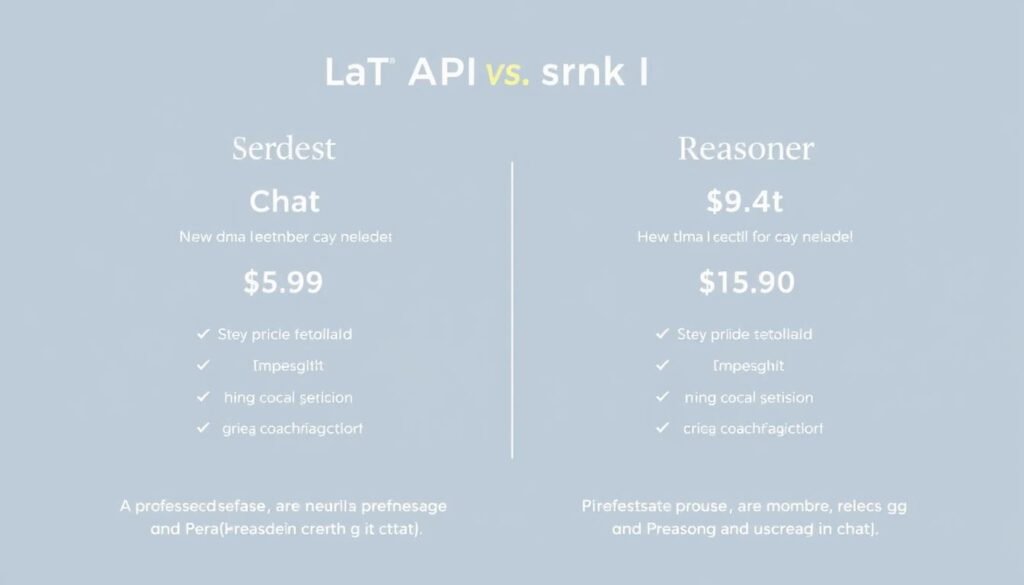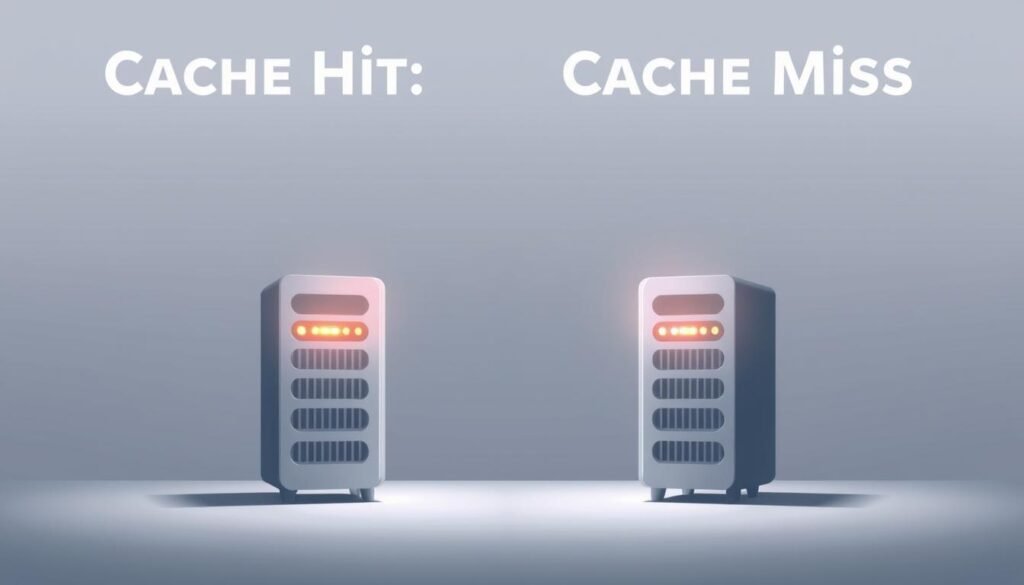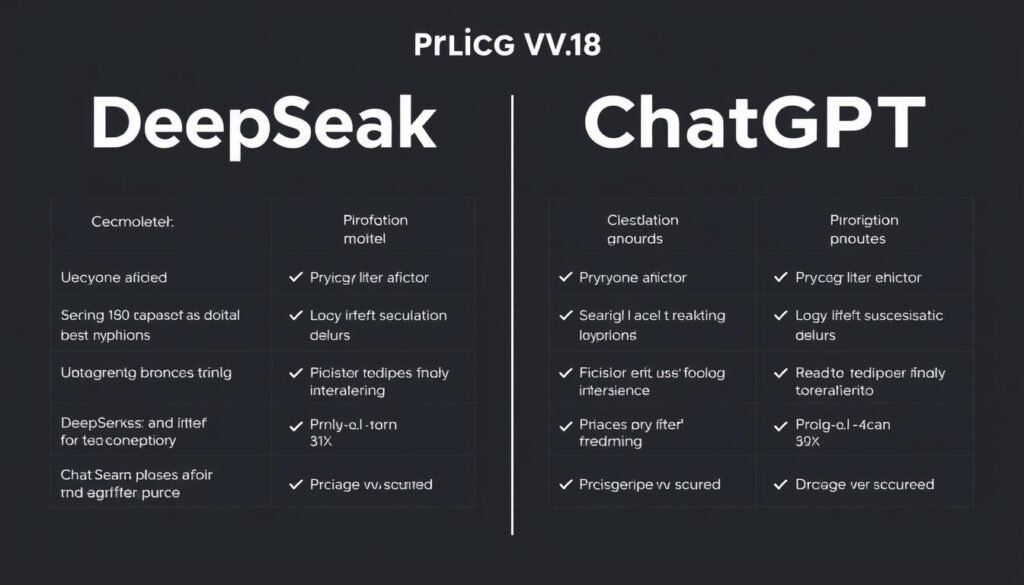Deepseek API: Affordable Pricing for Data-Driven Insights
The AI landscape is rapidly evolving, with businesses increasingly relying on data-driven insights to inform their strategies. A surprising fact is that the cost of processing and analyzing data using AI models has been a significant barrier for many organizations.
DeepSeek has disrupted this status quo by offering an open-source and cheaper alternative to prominent AI models like ChatGPT.
The token-based pricing model of DeepSeek API is revolutionizing how businesses approach AI-driven data analysis, making it more accessible and cost-effective.
Key Takeaways
- You’ll understand how DeepSeek’s token-based pricing works and its cost advantages.
- You’ll learn how to optimize your usage to maximize value while minimizing costs.
- You’ll gain insights into how DeepSeek compares to other popular AI models.
- You’ll discover how DeepSeek’s affordable pricing makes advanced AI accessible to businesses of all sizes.
- You’ll be able to make informed decisions based on your specific data processing needs.
Understanding DeepSeek API and Its Token-Based Model

To effectively utilize DeepSeek API, it’s crucial to understand its underlying token-based model. DeepSeek API’s pricing is based on token usage, which counts tokens differently for input and output. This approach allows for more granular and fair pricing compared to flat-rate models.
What is DeepSeek and How Does It Work?
DeepSeek is an AI model that processes text based on the input it receives. When you send a query to the DeepSeek API, it generates a response based on the input tokens. The number of tokens used for both input and output determines the cost. Understanding this process is essential for managing your API interactions and associated costs.
The Token System Explained
The token system is the foundation of DeepSeek’s pricing structure. Each piece of text is processed as countable units or tokens. The system differentiates between input tokens (what you send to the API) and output tokens (what the model generates), pricing them differently. This differentiation is crucial for estimating costs before running operations.
| Token Type | Description | Pricing |
|---|---|---|
| Input Tokens | Tokens sent to the API | Differently priced |
| Output Tokens | Tokens generated by the model | Differently priced |
Understanding the token system is vital for optimizing your prompts and managing your budget effectively when using DeepSeek API. By grasping how token usage is measured and billed, you can better estimate your costs and make informed decisions about your API interactions.
Breaking Down DeepSeek API Pricing
Understanding the pricing structure of DeepSeek API is crucial for businesses looking to leverage data-driven insights. DeepSeek API offers two primary models: DeepSeek Chat and DeepSeek Reasoner, each with its own pricing structure.

DeepSeek Chat Model Pricing
The DeepSeek Chat model is designed for conversational AI applications. Its pricing is based on the number of tokens processed. You can expect to pay a certain amount per million tokens, depending on whether it’s an input or output operation.
The cost structure is straightforward, making it easier for you to budget your AI-related expenses.
DeepSeek Reasoner Model Pricing
DeepSeek Reasoner is the more advanced model, designed for complex reasoning tasks. It costs $0.14 for 1 million token input with cache hit, $0.55 for 1 million token input with cache miss, and $2.19 per million tokens for output.
This model offers additional features like multi-round conversation and generating multiple Chains of Thought, enhancing the accuracy of its responses. The maximum CoT token number for DeepSeek Reasoner is 32K, making it suitable for intricate tasks.
- DeepSeek Reasoner represents the more advanced tier of DeepSeek’s API offerings, designed for complex reasoning tasks and enhanced accuracy.
- The pricing structure for Reasoner is higher than Chat: $0.14 per million tokens for input with cache hit, $0.55 per million tokens for input with cache miss, and $2.19 per million tokens for output.
- This model maintains the same 64K context length as DeepSeek Chat but offers an expanded 32K maximum Chain of Thought (CoT) token capacity.
- DeepSeek Reasoner’s key features include multi-round conversation capabilities and the generation of multiple Chains of Thought for more accurate responses.
By understanding the pricing and features of both models, you can make an informed decision about which one best suits your needs.
Cache Hit vs. Cache Miss: Impact on Your Costs

Understanding the difference between cache hits and misses is crucial for managing your DeepSeek API costs effectively. When using the DeepSeek API, your queries can either result in a cache hit, where the requested data is retrieved from the cache, or a cache miss, where the data needs to be processed and then cached for future use.
What Are Cache Hits and Misses?
Cache hits occur when the API can retrieve the requested information directly from the cache, reducing the need for additional processing. On the other hand, cache misses happen when the requested data isn’t available in the cache, requiring the API to process the request from scratch. The frequency of cache hits versus cache misses can significantly affect your overall costs due to the different pricing models applied to each scenario.
How Caching Affects Your Bottom Line
The difference between cache hit and cache miss pricing is substantial. For DeepSeek Chat, cache hits ($0.07 per million tokens) are nearly 75% cheaper than cache misses ($0.27 per million tokens). For DeepSeek Reasoner, the difference is similar, with cache hits ($0.14 per million tokens) being about 75% cheaper than cache misses ($0.55 per million tokens).
| Model | Cache Hit Price (per million tokens) | Cache Miss Price (per million tokens) | Cost Reduction |
|---|---|---|---|
| DeepSeek Chat | $0.07 | $0.27 | 74% |
| DeepSeek Reasoner | $0.14 | $0.55 | 75% |
To maximize cost efficiency, it’s essential to structure your queries in a way that maximizes cache hits. By doing so, you can significantly reduce your API costs, especially for high-volume applications.
DeepSeek vs. ChatGPT: Comprehensive Cost Comparison

DeepSeek and ChatGPT are two leading AI solutions with distinct pricing models that can significantly affect your business costs. Understanding these differences is crucial for making informed decisions about your AI investments.
Token Pricing Differences
The token pricing model is a critical aspect of both DeepSeek and ChatGPT’s pricing strategies. For businesses generating 10 million tokens per month, ChatGPT’s API would cost $900 for input and output combined, while DeepSeek’s more affordable pricing would cost $200 for the same usage level. This significant difference in pricing can have a substantial impact on your business’s bottom line.
Scaling further to 100 million tokens, the monthly bill for ChatGPT jumps to $9,000, whereas DeepSeek’s cost remains at $2,000. This disparity highlights the potential for cost savings with DeepSeek, especially for high-volume users.
Long-Term Cost Implications for Businesses
The long-term cost implications of choosing DeepSeek over ChatGPT become increasingly significant as your usage scales up over time. For businesses processing 10 million tokens monthly, DeepSeek could save approximately $700 per month compared to ChatGPT, amounting to $8,400 annually.
- The savings can be substantial, especially for high-volume users, with DeepSeek offering a more economical solution for businesses with large token usage.
- At enterprise scale (100+ million tokens monthly), the savings can exceed $7,000 per month or $84,000 annually, making DeepSeek an economically compelling choice for data-intensive operations.
- These cost savings can be reinvested in expanding AI capabilities, improving model performance, or funding other business initiatives, thereby enhancing overall business efficiency.
By choosing DeepSeek, businesses can achieve significant cost savings, which can be critical for maintaining budget discipline while expanding AI use cases.
Performance vs. Price: Is DeepSeek Worth It?

To determine if DeepSeek is a worthwhile investment, we need to analyze its performance in relation to its cost. DeepSeek’s efficient processing system ensures that users receive high-quality results without the delays or bottlenecks that can occur with other models.
Benchmarking DeepSeek Against Competitors
Benchmarking DeepSeek against its competitors reveals that it holds its own in terms of speed and accuracy. When comparing DeepSeek to premium models like ChatGPT-4, it’s clear that DeepSeek offers comparable or superior performance at a fraction of the cost.
Quality-to-Cost Ratio Analysis
The quality-to-cost ratio is where DeepSeek truly shines, offering performance comparable to premium models at a significantly lower price point. For instance, DeepSeek delivers exceptional value in use cases such as content generation, data analysis, and code development. By considering both token costs and the quality of outputs for your specific applications, you can evaluate the true ROI of AI models like DeepSeek.
As noted by experts, “The best AI models are those that balance performance with cost-effectiveness.” DeepSeek’s ability to provide high-quality results at an affordable price makes it an attractive option for businesses and developers alike.
- DeepSeek offers a compelling quality-to-cost ratio, making it suitable for a variety of applications.
- Its efficient processing system ensures high-quality results without significant delays.
- By analyzing specific use cases, you can determine the true value of DeepSeek for your needs.
5 User Groups That Benefit Most from DeepSeek API Pricing
With its token-based pricing, DeepSeek API offers a cost-effective solution for companies looking to scale their AI capabilities. The transparent and predictable pricing model makes it an attractive choice for various user groups.
Startups and Small Businesses
Startups and small businesses can greatly benefit from DeepSeek API’s affordable pricing. By leveraging DeepSeek’s cost-efficient models, these businesses can integrate AI into their products without breaking the bank. This enables them to compete with larger companies while maintaining a lean budget.
Developers and API Integrators
Developers and API integrators can seamlessly integrate DeepSeek into their applications using the provided tools. The predictable cost structure allows developers to offer competitive pricing for their AI-enhanced products while maintaining sustainable margins.
Educational Institutions and Researchers
Educational institutions and researchers can utilize DeepSeek API for various research projects and academic purposes. The affordable pricing makes it an ideal choice for institutions with limited budgets, enabling them to explore AI-driven research without excessive costs.
High-Volume Enterprise Users
High-volume enterprise users handling millions of requests daily can benefit from DeepSeek’s transparent pricing and efficient processing. The scalability of DeepSeek API makes it suitable for large-scale operations, catering to diverse use cases across different industries.
AI Product Builders
AI product builders creating commercial applications can maintain healthier profit margins by leveraging DeepSeek’s affordable token pricing as their underlying engine. By integrating DeepSeek’s capabilities into their products, AI product builders can offer competitive solutions powered by advanced models, enhancing their offerings in the market.
In conclusion, DeepSeek API’s pricing model is beneficial for a wide range of user groups, from startups to high-volume enterprise users. By providing a cost-effective and scalable solution, DeepSeek API enables businesses to innovate and stay competitive on a robust platform.
Cost Optimization Strategies for DeepSeek API
You can significantly reduce your expenses by implementing cost optimization strategies for DeepSeek API. Effective cost management is crucial for maximizing your return on investment (ROI) when using the API for your data-driven projects.
Maximizing Cache Hits
One of the most effective ways to optimize your DeepSeek API costs is by maximizing cache hits. Cache hits occur when the API returns a result from the cache instead of processing the request from scratch. By optimizing your input prompts and reusing similar queries, you can significantly increase cache hits and reduce costs. “Caching is a powerful technique for reducing costs, as it allows you to reuse previously computed results,” says an expert in API optimization.
Efficient Prompt Engineering
Efficient prompt engineering is another critical aspect of cost optimization. By crafting well-structured and specific prompts, you can reduce the number of tokens required for processing, thereby lowering your costs. This involves understanding the capabilities and limitations of the DeepSeek API and tailoring your prompts accordingly. Using tools provided by DeepSeek, you can analyze your prompt performance and make necessary adjustments.
Monitoring and Managing Token Usage
Monitoring your token usage is essential for cost management. DeepSeek provides tools to track your token consumption, allowing you to identify patterns and optimize your usage. By regularly reviewing your token usage reports, you can spot inefficiencies and implement strategies to reduce costs. For instance, you can set up dashboards and alerts to track your token consumption patterns across different models, projects, and time periods.
By implementing these cost optimization strategies, you can significantly reduce your expenses and maximize your ROI when using DeepSeek API.
Potential Limitations and Considerations
While DeepSeek offers competitive pricing, understanding its limitations is key to effective implementation. As you integrate DeepSeek API into your applications, you need to be aware of potential issues that may impact your results.
Security and Compliance Concerns
When using DeepSeek API, you must consider security and compliance concerns. Some users have reported biases in the outputs, particularly when handling sensitive content. For instance, a user named Cyrus John shared screenshots showing how DeepSeek sometimes produces results that seem more like propaganda than factual information. To mitigate this, you should implement verification processes for critical applications.
To address these concerns, you can take several steps:
- Implement confidence scoring systems to evaluate the reliability of DeepSeek’s outputs.
- Use human review workflows for high-stakes content to ensure accuracy.
- Regularly monitor and update your compliance measures to align with changing regulations.
Performance Consistency Issues
Performance consistency is another crucial aspect to consider. Users have reported occasional inaccuracies in DeepSeek’s outputs, which can affect the overall performance of your application. To optimize performance, you should:
| Strategy | Description | Benefit |
|---|---|---|
| Maximize Cache Hits | Optimize your prompts to increase cache hits, reducing the need for new computations. | Improved response time |
| Efficient Prompt Engineering | Craft precise prompts to get accurate results from DeepSeek. | Better output quality |
| Monitor Token Usage | Regularly track your token usage to avoid unexpected costs. | Cost efficiency |
By understanding these limitations and implementing strategies to mitigate them, you can effectively leverage DeepSeek API to achieve your goals.
Conclusion: Making the Right Choice for Your Data-Driven Projects
To make an informed decision about adopting DeepSeek for your AI needs, it’s essential to weigh its benefits against its limitations.DeepSeek offers compelling value through its token-based usage model, particularly for tasks requiring high-volume processing of content or complex analysis. However, its open-source nature presents both advantages for developers and potential security concerns for sensitive data handling.
When choosing between DeepSeek pricing and models like ChatGPT, you need to carefully evaluate your specificuse cases, budget constraints, and performance needs. Consider experimenting with DeepSeek on sample tasks relevant to your specific needs before committing to full implementation. For many cases, DeepSeek represents an excellent balance of performance and affordability.
Remember that the AI landscape evolves rapidly, so regularly reassess your needs and the available options to ensure you’re always using the most cost-effective solution for your data-driven projects. With proper implementation and an understanding of its strengths and limitations, DeepSeek can provide exceptional value for your projects while keeping costs manageable.
Ultimately, the right choice depends on your unique requirements, but DeepSeek’s competitive pricing makes it worth serious consideration for most AI applications.

